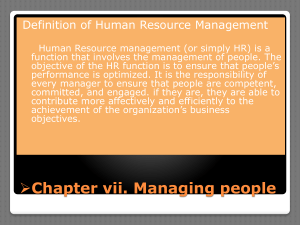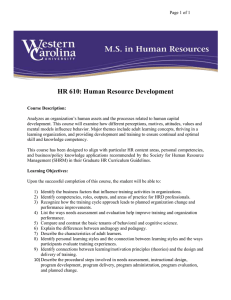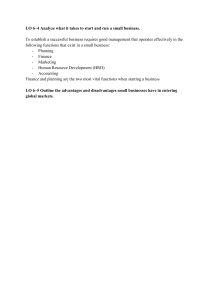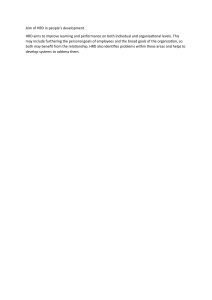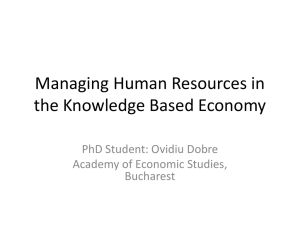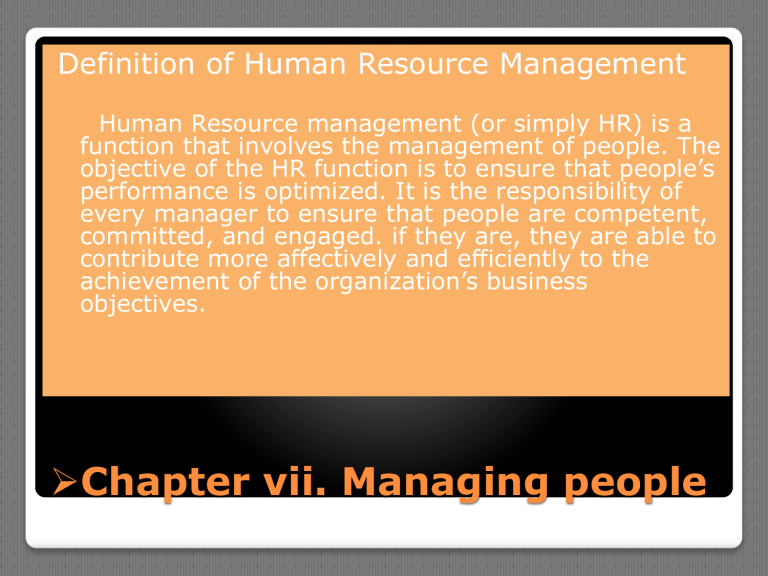
Definition of Human Resource Management Human Resource management (or simply HR) is a function that involves the management of people. The objective of the HR function is to ensure that people’s performance is optimized. It is the responsibility of every manager to ensure that people are competent, committed, and engaged. if they are, they are able to contribute more affectively and efficiently to the achievement of the organization’s business objectives. Chapter vii. Managing people The Origin of HR HR has metamorphosed from its humble beginnings dating back 1920 which is believed to be the year the HR function was born with the publication of the first discipline’s textbook titled , “Personnel Administration.”Then starting in the 70s, the name Personnel Department began to disappear from corporate organization charts, replaced by Human Resources Department, While in some cases the name change was motivated more by fashion than values, it did mark the beginning of a philosophical shift. Personnel was a loose collection of functions relating to people.”Human Resource "management looks at people as an organizational resource and focuses on maximizing that resource’s contribution to the organization’s success. Beginning year 2000 ,there was even a shift in the terminology used from human resources to human capital to emphasize that people are not just assets which organizations can use or misuse at will but rather a vital investment. Truly, the role of HR from being a personnel records keeper and picnic planner has gone a long, long way from its humble beginnings. The HR framework 2 HRD is people-focused while HR is systems-focused. This simply means that when you take a look at the functional areas of HR on the left side, the recipients of all human resource development (HRD) interventions are people. On the other hand, human resource management (HRM) on the right side ensures that there are strong systems and internal processes on the functional areas cited so that people can function more effectively. Human Resource Development (HRD) Human Career Organization Development Performance Management Employee Relations Learning and Development Resource Management (HRM) Design Workforce Planning Recruitment/Sele ction/Placement Rewards and Recognition Human resource DEVELOPMENT(HRD) 1.Career Development - an HR function that tracks an employee’s career (a sequence of separate but related jobs) that provides direction, continuity, order and meaning in an employee’s life . 2.Performance Management - a function where the performance of an employee is regularly appraised as basis for giving him/her a merit increase and\or promotion, and guide him/her in further developing his/her competencies. 3.Employee Relations - a function that promotes employee engagement and commitment to the organization through efforts at relating well, motivating, disciplining, and communicating with employees. 4.Learning and Development - a function where employees provided training and development through various interventions such as on-the-job training ,coaching and mentoring, and classroom training which are all designed to enhance his/her knowledge, skills, and behavior. Human Resource management( hrm ) 1.Organization Design - a process of putting up the appropriate type and form of the organization that will suit its overall business purpose. It is meant to establish the type of structure that will make the organization effective, efficient, attuned to the times, and responsive to its business requirement as well as employees 'needs. 2.Workplace planning - a process of determining and identifying the right quantity and quality of people to be hired. It precedes any recruitment any recruitment effort. The organization has to know first the right number of people to be hired in order to avoid a situation where it can be over-manned or undermanned. On the other hand, the organization has to figure out what sort of competencies(knowledge, skills, and behavior)the employees should have for them to become successful in order to ensure that organization hires only those people who possess such competencies. 3.Recruitment,Selection, and Placement – a process of sourcing, identifying, selecting and hiring candidates for certain jobs based on the proper matching of candidates’ qualifications and jobs specifications, including their competency requirements. 4.Rewards and Recognition – a process of identifying monetary compensation such as salary, benefits and other perks, and non-monetary compensation such as awards, commendations, and other similar types of remuneration, incentives, and other considerations to motivate and inspire employees. Recruit, Employee life cycle 5 Select, Orientation Disengagement Monotony Setting-in Competent Performance An individual is recruit and what follows is his/her orientation. The new employee sets in, learns about organization, its operations and its people, among others, and acclimatizes himself/herself with the practices of the organization. The employee is expected to turn in satisfactory, if not competent performance, in return for remuneration commensurate to his/her qualifications and functions. A fair day’s pay for a fair day’s work. As he/she grows in the organization, there comes a time when the employee will find the job monotonous and he/she starts to become complacent. There are even instances when, other just becoming complacent, the employee becomes disengaged. The value of human resource management becomes more pronounced as the reader gets a glimpse of the employee life cycle above, necessitating HR interventions every step of the way through human resource development initiatives, and through strong systems and internal processes through human resource management actions. Why Is Modern People Management More Critical at the Present Time People management has become more challenging and critical at the present time, given the change that are taking place in the environment: 1. Changing mix of the workplace (more female employees: more working mothers, greater demand for gender equality, with emphasis on women’s rights) 2. Changing values of the workplace (flextime, work-life balance, virtual HR, cafeteria benefits) 3. Changing demands of employers (automation, technological advancement, outsourcing) 4. Changing demands of government (Department of labor promulgations, new government legislations) HR professionals are expected to bring to top management’s attention the needs and expectations of employees. it is HR’s primary responsibility to optimize employee’s performance, it is also expected that HR professionals find ways to increase productivity by enhancing employee’s competencies as well, finding ways to motivate, engage, and inspire employees to perform well and achieve the organization’s goals. HR professionals should lead in the organization’s change efforts. Organizations should not become obsolete. Since there are changes happening outside the organization, HR professionals have to ensure that the organization itself changes and keeps pace with requirements of the external environment. Dave Ulrich identified the challenges of HR in becoming a strategic partner: o By facilitating diagnosis, HR turns strategies into action. o HR should focus on a performance balanced scorecard by paying attention not only to meeting employees’ expectation but also to coping with the financial, costumers, and process issues visà-vis the organizations goals. o HR’s plans should be aligned with the business plans. In the process of benchmarking with other companies, HR should not use the information as a standard but only as baseline.HR should not make the mistake of benchmarking only for the purpose of following the lead of other companies which have done well. o HR should be able to build core competencies or capabilities within the company in order to provide for effective leadership succession, attain business success, and even in turbulent times, survive crisis. o Before we leave this segment of the book, this writer will tackled about in the HR community-strategic HR. In order to set the right perspective, a strategic partner is a human resource manager’s role to gives him/her the opportunity to have a meaningful voice in establishing and implementing organization strategy which is necessary for business growth. According to David Ulrich the challenges of HR in becoming a strategic partner and this writer has ventured into summarizing them: 1. By facilitating organization diagnosis, HR turns strategies into actions. 2. HR should focus on a balanced scorecard by paying attention not only to meeting employees’ expectations but also to coping with the financial and customer issues visà-vis the organization’s goals as well as establishing strong systems and internal processes. 3. HR’s plans should be aligned with the business plans. THE NEW CENTURY HR OPPORTUNITIES AND CHALLENGES Talent Management Recruiting and retaining talent worldwide. This has always been number one in the list. Leadership Development Developing leaders who are capable of thinking, inspiring, and acting in the global arena. These leaders are vital to the success of organizations especially in a knowledge-based economy. Strategic HR Increasing HR’s role as a strategic business partner. Being able to know the business, developing a line of sight that will align HR’s goals with the organization’s goal’s and, and all the time, finding one’s seat at the corporate table and helping grow the business. Different Training Programs The main reason for this is that “learning by doing” provides the opportunity for the trainee to immediately absorb what he/she learns because of the hands-on experience that OJT allows. On the other hand, classroom training is mostly dependent on the individual. Training through interaction with others allows the trainee to learn from someone like a coach or a mentor. Effective Reward System Rewards system is an important and critical part organization design. One way of designing a reward system is to consider the basic organization design, driven by its existing resources and environment, as well as the personal values and management style of the owners. LEADING vs. MANAGING Are you manager or a leader ? Which is better ? MANAGING LEADING Command others Inspires other Task-focused Vision-focused Provides direction Provides context High control Low control Trust self Trust others And finally, managing employs “command and control” techniques while leading generates “people empowerment”
